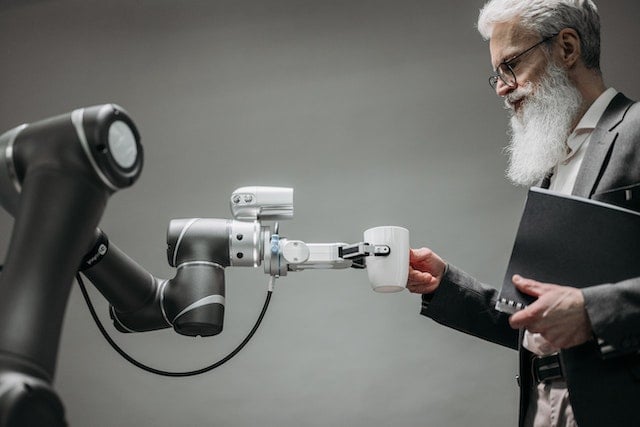Updated: September 9, 2025- 11 min read
Oh, AI. The acronym on everyone’s lips. For any of you who were living in an analog bubble, AI means Artificial Intelligence – intelligence created by advanced machine programming, wherein the machine demonstrates the ability to perform tasks, synthesize information, and make decisions typically requiring human intelligence.
AI, and generative AI specifically, has taken off exponentially in the public eye since the generative AI platform ChatGPT became a viral sensation at the end of 2022. It’s all the internet is talking about. From memes, to LinkedIn posts listing “25 Can’t Miss GenAI Products!”, to excited announcements from innovators, to serious think pieces from futurists and philosophers, it’s inescapable.
You can love it or hate it, be scared or thrilled about it, but it’s here to stay and disrupt countless industries. The question is: How will it disrupt the Product Management profession? And, more importantly… Will AI replace Product Managers? (Signs point to no! At least for now 😉)
10 Product Management Skills That AI Will Never Automate

AI can do a lot, and every day it can do more. But there are some core Product Manager functionalities that AI doesn’t quite fulfill. Humans constantly have to act with incomplete inputs, and Product Managers more than most. AI doesn’t do so well with incomplete inputs.
That’s why these 10 Product Management skills are hard for AI to automate:
1. Creating Strategic Visions and Roadmap
Product Managers connect customer needs to business needs and market reality. AI can support Product Managers sort through data and identify patterns, but it shouldn’t make the final call on Product Strategy. We need to make strategic decisions with discretion; AI will have a hard time understanding the full context of the situation.
Product Managers are better suited to think in the long term. Neither Product Managers nor AI can tell the future, but humans are much better at thinking in the hypothetical – based on an intimate knowledge of the market, of course. Setting a strategic, high-level vision does need to be based on evidence. But when planning for 2-5 years down the road, some imagination is needed.
Product Managers are also better suited to create and maintain the shorter-term implementation of the Product Strategy and Vision: the Product Roadmap. A human touch helps the Product Team navigate the twists and turns of Product Development. Pivots in development are normal, and strong leadership from a Product Manager shepherds the team to a successful launch.
2. Stakeholder Management

Aligning the team on Product Strategy and Roadmap is arguably the most important part of a Product Manager’s job. You can set an incredible strategy, but that means nothing if you’re unable to implement it. You need buy-in from the Product Team, leadership, and sometimes from external stakeholders.
AI struggles to understand the nuances of human emotions and needs. It won’t know that it’s essential to get the opinion of the introverted Lead Engineer before development (even if they’re shy to share) because it usually shaves off 2-3 weeks of time in the development process. It won’t know how to de-risk big bets and convince leadership to invest in innovative ideas, or how to block out the noise from opinionated but misinformed stakeholders.
Understanding tone of voice, body language, and stakeholder motivations and relationships is, for now, something that humans are better equipped to navigate than AI.
Again, AI can be a valuable support system for data analysis – using data to back up decisions is an important part of stakeholder management. But it falls short in relationship building, an equally essential part of the puzzle.
3. Build and Motivate a Team
Product Managers need to interact with lots of people to do their job well. Cross-functional stakeholders, leadership, users – there are lots of moving pieces, opinions, and information to tap into. But the core of a Product Manager’s communication is the Product Team.
Of all the stakeholders, these are ones Product Managers need to prioritize amongst all the other considerations. Aside alignment and communication on practical matters, Product Managers have a finger on the pulse of team motivation and cohesion.
If the team isn’t working well together, it’s the Product Manager’s task to understand why and bring efficiency back to the team.
4. Product Evangelism and Communication

And to have an efficient team, it helps if they’re excited about what they’re building.
AI can have conviction, as seen when it stubbornly defends hallucinations. But this blind conviction is not the same kind of conviction Product Managers need.
Product Managers need to believe in the long-term strategy and vision they’ve created, and evangelize this to the rest of the company. This isn’t to say Product Managers will always be right – few decisions in Product can be made with 100% certainty.
But if you’ve ever tried to choose which restaurant to go to with an indecisive person, you’ll understand how looking for certainty can be a counterproductive waste of time. Sometimes you need someone to say, “let’s go to this restaurant, it’s great” so you can actually eat before your lunch break is over.
Conviction in the face of uncertainty drives action. There needs to be someone there confident in the vision, someone who will convince everyone to stay the course and nudge them back on track in the face of distractions and competing priorities. Product Managers serve this function for the team and other stakeholders.
We need Product Managers to say, “let’s go in this direction” and help the team feel good about moving in that direction together. Even if you make a wrong turn, communicating vision and results with your team will help them better pivot together when needed. That way, when emerging data leads to a change in strategy, everyone will understand why the change is happening.
Conviction in Product evangelism doesn’t mean the Product Manager will be right all of the time, but communicating the Product Vision and the reasons behind it will help your team work effectively towards that vision.
AI lacks this context to their conviction, and lacks the storytelling and persuasive capabilities that Product Managers use every day to communicate with their team.
5. Leadership and Team Collaboration
Though we’ve stressed the importance of Product Managers communicating with their own team, they also have the responsibility of cross-functional communication. For similar reasons that cause AI to struggle with stakeholder management and product evangelism, it’ll struggle with cross-team collaboration.
Emotional intelligence is not the kind of intelligence that AI excels in. Even if we give it an input of motivations and emotions of cross-functional stakeholders, it will have trouble communicating with them about the product in an impactful way. Successful leaders help their coworkers feel heard and alter their communication style based on what they know about the person. AI could write a million blog posts but still struggle to communicate 121 with employees in a human way. AI might be able to eliminate management, but never leadership.
The way designers, engineers, customer success, marketing, and sales view the product is completely different. All of their inputs are valuable, as is your input to them. Customer success, marketing, and sales need to understand the product to do their job better. And the product needs designers and engineers involved throughout the Product Lifecycle. Product Managers lead this cross-functional collaboration to make sure the product is of the highest quality possible.
6. Adaptability and Creativity

AI runs off algorithms; developers use huge datasets and reinforcement learning from human feedback to train these algorithms. Further, unless you develop your own AI, the AI solutions trying to take over your job (allegedly) are products from other companies. This means you can’t crack open the hood to adjust the algorithm to your needs – you’re dependent on product updates from the AI provider.
Because the outputs the AI comes up with are limited to its dataset, you can also run into the issue that the AI is not always up to date. Google’s GenAI chatbot Bard is an exception to this, as it continually draws information from the internet to update its algorithm. But in general most AI’s won’t have the reach and access to information as a product from Google.
All this to say that Product Managers are uniquely positioned to respond to changes in the market and emerging technologies. They are able to respond to quickly and redirect the product where needed. In the face of new challenges, humans are still uniquely suited to come up with creative solutions.
7. Decision Making and Trade-offs
Decision making can be challenging – in fact, some decisions should be challenging. Some decisions are easy of course, but decisions to pursue big bets and innovation should not be made lightly.
AI might find making big decisions too easy. Yes, being decisive is a virtue, but the cold rationale of an AI decision may lead Product Teams astray. Sometimes you need more than data to identify the best solution, especially when making decisions with incomplete information. AIs are not comfortable with ambiguity, while Product Managers must be.
How would an AI Product Manager make a trade-off between 2 high-priority factors? Who would take responsibility for a poor decision and guide the team through addressing it?
AI will assuredly become an invaluable partner to Product Managers in decision making, but it shouldn’t replace human judgment in the final decision. Human intuition and experience, paired with data, result in the best decisions.
8. User Research and Empathy

As good as AI is at picking up on the subtleties in data, that’s not the only skill necessary to conduct good user research. Uncovering user needs and pain points usually comes from stumbling onto unexpected insights. Sometimes these insights come from qualitative data; sometimes they come from patterns in quantitative data. AI can help you identify the patterns in the quantitative data, or even patterns in concepts and vocabulary in qualitative data, but a human reading of those patterns is what delivers actionable insights.
The data doesn’t always make sense at first glance, and it takes understanding context and using imagination to put yourself in the users’ shoes. This empathy-building capacity is something that’s still restricted to human intelligence. AI's limitations in comprehending human emotions, motivations, and experiences is a hindrance here.
9. Identify a problem in need of a solution
In a similar vein, AI can help Product Managers identify patterns in market trends, but can’t imagine the full context of the problem and solution. That’s why Product Managers are essential in Product Discovery. Product Managers are problem-solvers at heart; understanding the problem is one of the most challenging parts of a Product Manager’s job. A poor understanding of the problem leads to a low-value product.
Unmet needs may not have a lot of data surrounding them, so it takes a sharp eye and intuition to recognize emerging problems early on (and before the competition does). AI can be an incredibly powerful and helpful tool, but we still need the Product Manager’s intuition for effective problem recognition.
10. Propose and pitch a solution

Product Discovery doesn’t end with identifying the problem. Then comes the exciting part: Finding a solution (your eventual product or feature)! Product Managers are needed in the Product Discovery phase not only to identify changes and opportunities in the market, but also to bring the team together in solutioning.
Here is when your communication skills come into play. Talk with designers, engineers, and leadership to make sure the proposed solution adds value to users and is possible from the technical and business sides (feasible, desirable, viable).
The art of crafting a compelling solution and pitching it to stakeholders still falls squarely in the wheelhouse of the Product Manager. Again, AI can be a great support here through generating recommendations and data-driven insights. But ultimately it’s the Product Manager who will propose the solution in order to convince stakeholders.
Conclusion
We predict that AI will never be able to replace Product Managers, they will be part of a Product Manager’s toolkit – either to complete their own tasks or in the product solutions they build.
Jonathan Rochelle, VP of Product at LinkedIn, has predicted that all products will be AI products in the future. First software ate the world. Now AI is eating software.
Any Product Manager worth their salt is seeing these changes and quickly jumping into the fray. Product Managers are innovators after all, leading the direction of the software world one launch at a time. They have the opportunity, and indeed the responsibility, to decide how disruptive technologies will fit into our futures on a practical basis.
Even though AI can still feel like something out of sci-fi instead of real life, from now on Product Managers need to take AI solutions into consideration as they help create the software and hardware that shapes our world.
Updated: September 9, 2025





